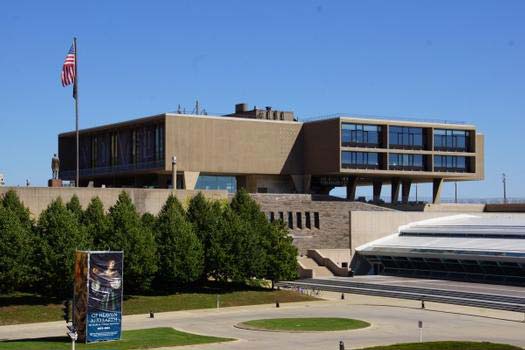The WMC is the focal point for various veteran, patriotic, cultural, art, and educational activities. It was born out of the collective vision of the Zonta, Altrusa, Business and Professional Women’s Club, and the Milwaukee Civic Alliance to create a fitting memorial to honor the War Dead of WWII.
The WMC is the focal point for various veteran, patriotic, cultural, art, and educational activities. It was born out of the collective vision of the Zonta, Altrusa, Business and Professional Women’s Club, and the Milwaukee Civic Alliance to create a fitting memorial to honor the War Dead of WWII. Inspired by their vision, fundraising began, and the community pooled its resources. The building was dedicated on Veterans Day in 1957 as testament to the men and women who served our nation when called. Our mission remains, “Honor the Dead by Serving the Living” through the principles of art and peace.
This stunning architectural achievement of renowned Finnish-American architect Eero Saarinen, whose projects also included the St. Louis Gateway Arch, New York’s John F. Kennedy Airport, and Dulles International airport in Washington, D.C., stands as Southeast Wisconsin’s most visible tribute to those who have served in the United States Armed Services. Saarinen’s unique design of concrete, glass, and granite around the open space, and a floating cruciform with cantilevered portions, is now considered a classic in the development of modern architecture. The WMC was designated a Milwaukee Landmark in 1974 in honor of its architectural and cultural significance to the community.

The WMC is the focal point for various veteran, patriotic, cultural, art, and educational activities. It was born out of the collective vision of the Zonta, Altrusa, Business and Professional Women’s Club, and the Milwaukee Civic Alliance to create a fitting memorial to honor the War Dead of WWII. Inspired by their vision, fundraising began, and the community pooled its resources. The building was dedicated on Veterans Day in 1957 as testament to the men and women who served our nation when called. Our mission remains, “Honor the Dead by Serving the Living” through the principles of art and peace.
This stunning architectural achievement of renowned Finnish-American architect Eero Saarinen, whose projects also included the St. Louis Gateway Arch, New York’s John F. Kennedy Airport, and Dulles International airport in Washington, D.C., stands as Southeast Wisconsin’s most visible tribute to those who have served in the United States Armed Services. Saarinen’s unique design of concrete, glass, and granite around the open space, and a floating cruciform with cantilevered portions, is now considered a classic in the development of modern architecture. The WMC was designated a Milwaukee Landmark in 1974 in honor of its architectural and cultural significance to the community.
Memorial Day to Labor Day
8AM-8PM daily
Labor Day to Memorial Day
8AM-6PM daily